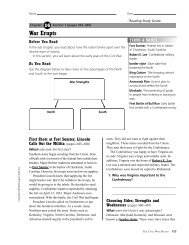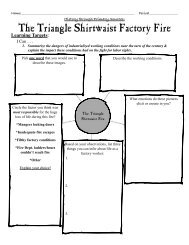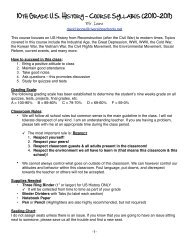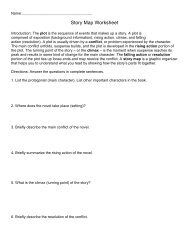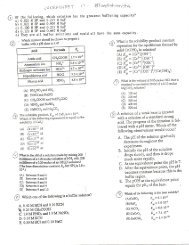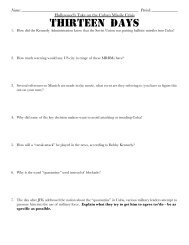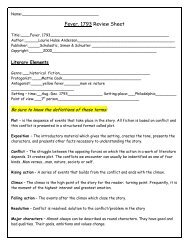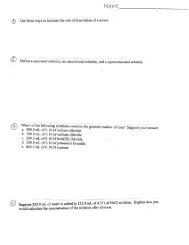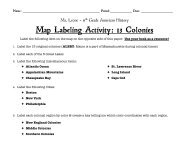Chapter 16 Text
Chapter 16 Text
Chapter 16 Text
Create successful ePaper yourself
Turn your PDF publications into a flip-book with our unique Google optimized e-Paper software.
<strong>16</strong>.4 The PH Scale 623<br />
r<br />
fr' ' '<br />
L^lvm--<br />
Cola, vinegar<br />
T4r:<br />
T<br />
TJ<br />
to<br />
1 1<br />
Black coffee - 1X105<br />
Rain i\din<br />
Saliva<br />
- 1X10~6<br />
"h /f:n.<br />
Milk<br />
Human blood, tears - -- ixlO"7<br />
Egg white, seawater - -<br />
Baking soda<br />
- lxlO~8<br />
„ Borax - 1X10~9<br />
Milk of magnesia<br />
- 1XHT10<br />
Lime water<br />
Household ammonia - -<br />
Household bleach<br />
NaOH, 0.1 M-<br />
~;"1 (lxlG~°)<br />
- ixip~v :<br />
— ixio~2<br />
- .ixicrV:<br />
i vin~4<br />
J. AT 1U<br />
-ixio-11 -;<br />
- 1X10"12<br />
-IxlQ-13...;.<br />
- IXIXT14 i<br />
pOH •4 Figure <strong>16</strong>.5 H+ concentrations<br />
and pH values of some common<br />
substances at 25°C.<br />
estimated using the<br />
concentrations of H<br />
-", 0.0 "•: .','• •14.0"""- -. 1X10^}4:<br />
:' ijo ;. " 13.0 ". ' ixio1^ .<br />
2.0 12.0 ixib~12 . .<br />
; 3.0 11.0 ixid"11<br />
4«U n inn -IU.U 1 l^slU v 1 n~io •<br />
5.0 9.0 1X10~9<br />
6.0 8.0 1X10~8<br />
7.0 7.0 1X10"7<br />
8.0 6.0 1X10~6<br />
9.0 5.0 1X10"5<br />
lo.o 4.0 ixip~* •..:,..<br />
11T0. .3.0 lxlO~3<br />
12.0 2:0 1X10"2<br />
::13.0 1.0 . ixlp"1,<br />
. 14.0- . 0.0, . Hixio"0)<br />
^<br />
(» ACTIVITY<br />
Jtrn pH Estimation<br />
SAMPLE EXERCISE <strong>16</strong>.6<br />
Calculate the pH values for the two solutions described in Sample Exercise <strong>16</strong>.5.<br />
Solution<br />
Analyze: We are asked to determine the pH of aqueous solutions for which we have<br />
already calculated [H+].<br />
Plan: We can use the benchmarks in Figure <strong>16</strong>.5 to determine the pH for part (a) and<br />
to estimate pH for part (b). We can then use Equation <strong>16</strong>.17 to calculate pH for part (b).<br />
Solve: (a) In the first instance we found [H+] to be 1.0 X 10" 12M. Although we can use<br />
Equation <strong>16</strong>.17 to determine the pH, 1.0 x 10~12 is one of the benchmarks in Figure<br />
<strong>16</strong>.5, so the pH can be determined without any formal calculation. ?<br />
pH = -log(1.0 x 10~12) = -(-12.00) = 12.00<br />
The rule for using significant figures with logs is that the number of decimal places<br />
in the log equals the number of significant figures in the original number (see Appendix A).<br />
Because 1.0 X 10~12 has two significant figures, the pH has two decimal places, 12.00.<br />
(b) For the second solution, [H+] = 5.6 X 10"6 M. Before performing the<br />
calculation, it is helpful to estimate the pH. To do so, we note that [H+] lies between<br />
1 X 10"6 and 1 X 10~5.<br />
1 x 10~6 < 5.6 X 10~6 < 1 X 10~5<br />
Thus, we expect the pH to lie between 6.0 and 5.0. We use Equation <strong>16</strong>.17 to calculate<br />
the pH.<br />
pH - -log5.6 x KT6M = 5.25<br />
Check: After calculating a pH, it is useful to compare it to your prior estimate. In this<br />
case the pH, as we predicted, falls between 6 and 5. Had the calculated pH and the estimate<br />
not agreed, we should have reconsidered our calculation or estimate, or both.<br />
Note that although [H+] lies halfway between the two benchmark concentrations, the<br />
calculated pH does not lie halfway between the two corresponding pH values. This is<br />
because the pH scale is logarithmic rather than linear.



